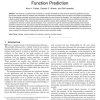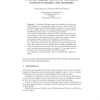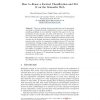252 search results - page 27 / 51 » Using OWL to model biological knowledge |
TCBB
2010
13 years 7 months ago
2010
—The literature on protein function prediction is currently dominated by works aimed at maximizing predictive accuracy, ignoring the important issues of validation and interpreta...
AWIC
2003
Springer
14 years 12 days ago
2003
Springer
Abstract. We present a dialogue system that enables the access in natural language to a web information retrieval system. We use a Web Semantic Language to model the knowledge conv...
BIOCOMP
2008
13 years 10 months ago
2008
Background: Inferring a gene regulatory network (GRN) from high throughput biological data is often an under-determined problem and is a challenging task due to the following reas...
CAISE
2004
Springer
14 years 2 months ago
2004
Springer
Abstract. The definition of a domain ontology is a complex activity that requires two kinds of expertise: a deep knowledge of the domain to be modeled and a good level of familiari...
SEMWEB
2010
Springer
13 years 6 months ago
2010
Springer
There are ontology domain concepts that can be represented according to multiple alternative classification criteria. Current ontology modeling guidelines do not explicitly conside...



